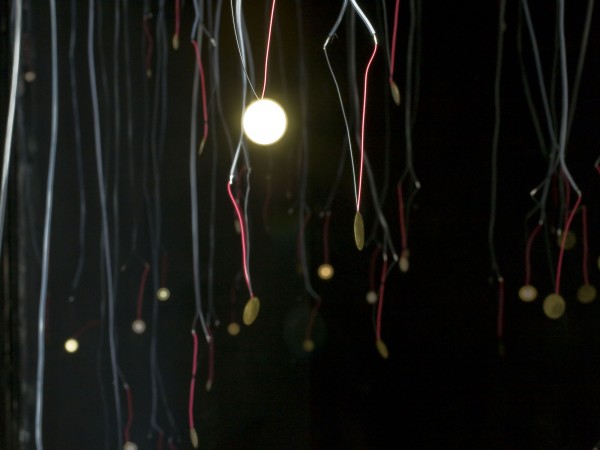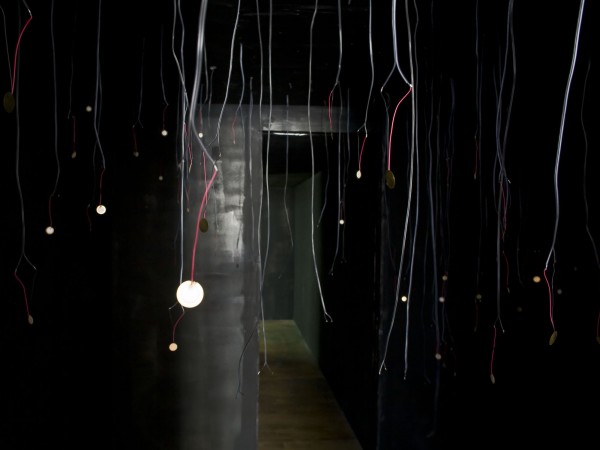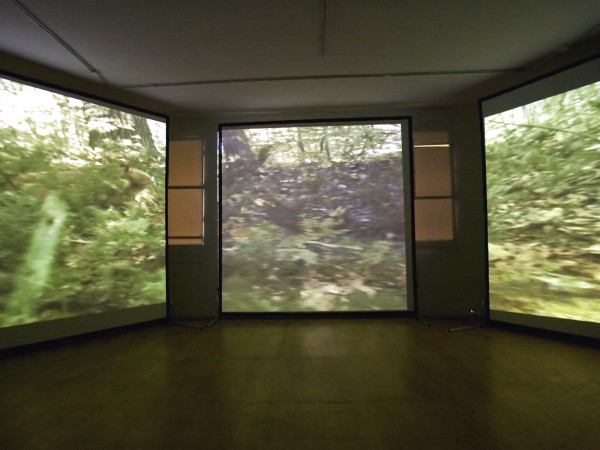The electronic music and free jazz composer, radio animator, audio art curator and contemporary artist Érick d’Orion presented his work Forêt d’Ifs at LA CHAMBRE BLANCHE. His preceding work, the installation Solo de musique concrète pour 6 pianos sans pianiste was shown in Oboro gallery in 2007. In Forêt d’Ifs, the artist set aside his play with direct references to objects that was a feature of Solo de musique. Instead, d’Orion’s intervention at LA CHAMBRE BLANCHE employed a formal approach that evoked certain experiments by Servaas, or else the opening seconds of Vostell’s Sun in your head1, created in the 1960s. Through his exploration of movement and distortion, d’Orion demonstrated the influence, on his inspired work with sound, of certain forms found in Bruitist works and Russolo’s Arte dei Rumori (1913).2 Vostell worked with disorder, using structures and forms of narration influenced by the culture of 1960s America. Forêt d’Ifs foregrounded a more subject and individualist approach in which the artist employed the forms of abstract art, combined with an exploration of noise, which drew the audience into the vast interpretive space opened up by installation art. D’Orion’s hyperfluxus experimentation dealt as much with the instantaneity of, “liveness, revisited in recordings,” which is associated with site-specific performance (evoking the beyond of the forest), as it touched on the technique of the manœuvre. Notably, in Forêt d’Ifs interactivity reinvoked linearity, through the work’s looped video element. Whilst in Solo de musique the artist worked with familiar objects, juxtaposing associations, underpinned by the concrete referent of the piano object, the objects in Forêt d’Ifs were anchored in a beyond space offered up by d’Orion for our consideration. This conjured up the visual dimension of research that, in a manner of speaking, dealt with the ‘music’ of sounds. Thus a reading of the artist’s installation at LA CHAMBRE BLANCHE in terms of sound exploration offers a way into his incursion in the art of the image. Such a reading opens up the question, amongst others, of a Bruitist mathematics, as applied to the codes of video installation. The work required an additional and inverse effort, that of a return to the semi-abstract image, by way of sound become object, through its amplification and its intemperance A formal reading of the installation Forêt d’Ifs in terms of “sound vision” emphasizes abstraction and invites interpretive research in cyber history: we will all Google d’Orion.
Forêt d’Ifs consisted of two distinct sections: a dimly-lit vestibule area featuring a sound work comprised of miniature speakers suspended from the ceiling, which visitors were required to cross3 to reach a second space containing a three-screen video projection. In the first section, the miniature speakers (with the dual function of microphones) emitted barely-audible sounds, which were discernible only by listening attentively. These miniaturized sounds could only by heard during the rare moments of silence in the soundtrack of the adjoining work. This deafening soundtrack filled the entire space, its amplification spilling out onto the street. As soon as the door of the space was opened, the sound coming from the speakers was so strong as to cause the building’s walls to vibrate. In practical terms, the installation broke down boundaries, ran amok; as visitors crossed its threshold and enter the vestibule area, with its black-painted walls and cables hung from the ceiling, it became clear that the spirit of the work was that of confrontation, of silence speaking through noise.
Did the cables hanging from the ceiling represent a forest? Was a form of immersion offered up by the enclosed space of the vestibule area? The first feeling of confrontation experienced by the audience took place in the passage towards the projection. Once spectators had traversed the antechamber, they came face to face with three projections arranged in a triptych, allowing little space in which to stand back from the work. This conflicting and antinomical face-to-face alluded to the heart of the work, in that the sense of immersion felt was that experienced when seated in the front rows of the cinema, the immersion found in La Ciotat.4
D’Orion’s imagery imposed itself on our gaze, as the sound waves in his work flooded the space, seeming almost brutal. So it was that, pragmatically, the installation used impact to reconfigure our senses, as our immersion in the contemporary world was emptied out, to be replaced by conceptual formalism. The experience of immersion in the work was primary, and not that associated with media art; a form of immersion that speaks of alterity (we are immersed in this world that surrounds us). This basic immersion was brutal, taking hold of us, creating a form of promiscuous relationship between the eye and the image, through the impact of noise. The video imagery evoked a walk in a forest, with the depiction of movement in the walk flouting all cinematographic conventions. The filming process appeared of secondary importance to the artist, as the camera swung in all directions, as though hanging from a cable. D’Orion let this cable do the talking; as we watched it was the cable that spoke. The video conveyed disorder, as the images came in blocks, discernable only in fragments: a dog amongst leaves, the green of foliage. Where were the much-anticipated yew trees? They appeared suddenly, before the infernal circle recommenced, turning endlessly. How could we be sure it was them? In technical terms, the sliding movements of the camera defied the physical distance between the three screens, as the “cable” used in the filming made no acknowledgement of the space between capturing and projecting the images. Moreover, the resolution of the work created the impression that a single video had been spread across three screens, that its 720 pixels were divided between their surfaces. This impression was confirmed by the artist: the projection consisted of a single video shoot. The combination of the single shot and low image resolution, projected on a large scale, moving from one extremity of space to the other, caught us unawares and blurred all narrative structure. This neo-Fluxus-like approach is that of an art characterized by the instantaneity and ephemerality of a digital era in which “everything is possible.” The artist’s role is that of a re-director, who transports the audience into an experience that forces them to stop. The audience must pause to think, in a process that reflects the artist’s adherence to the mission of the gallery: to explore the site-specific nature of art.
Site-specific art can be approached in a variety of ways. In this case, as the artist’s text that accompanied the work explained, “the yew forest” to which the title alludes undoubtedly constitutes part of the interpretive framework of the installation, but a fuller reading requires further research. The artist provides a number of clues: the yew trees in question come from a forest on the Ile d’Orléans. Thus, the confrontation in question is that between the tranquility of the forest and its proximity to the noise of the city. Such clues are necessary and welcome. When we visit the artist’s website, a new avenue of interpretation opens up. The artist is self-taught, an experimenter therefore and, essentially, his methods are based on his exploration of sound. Further research on Google reveals that d’Orion draws on a range of references, that speak of immediate ecologies, of creating links between different environments – whether the nearby forest and the gallery premises or another –, of integrating the art work and the audience. However, the experience before us at LA CHAMBRE BLANCHE is “in progress”, not all the elements involved are present. A distance exists between what is presented and the background of the work. The confrontation in question in his work spoke of opposite forces, those of: nature and construction; site-specificity and the beyond; noise and silence; the within and the without; presence and absence. The aspect that most caught my attention related to the dialogue between nature and construction. A two-fold antimony is at stake, involving urban space and nature, representation and the void of sound space. It is difficult to locate the silence of the forest in d’Orion’s work. Moreover, the irregular movement of the camera challenges our capacity to follow the imagery, questioning the natural hyperactivity of the gaze. Cognitive scientists have proven that consciousness is modeled through a rapid succession of images. This incarnates action, action that seeks to understand and to construct, model and validate the world in which we are evolving. Such is the case in Forêt d’Ifs, where even tranquility must be understood in terms of speed. D’Orion manipulates the camera and seeks for us.
The installation spoke of image technology by demonstrating its opposite, in pointing to forms that immerse the viewer and invite them to choose. In contrast to imagery that synthesizes a viewpoint, guided by the handling of the camera, d’Orion’s work offered no choice but to allow the onslaught or leave. The audience was offered no means of stopping the cycle before them. Even if – as the artist desires – an integration takes place between art work and viewer, such an event occurs despite the viewer who, rather than exerting choice, is captured in the constraints of an interactive loop.
The installation signaled the capacity of autodidactic approaches to open doorways of inquiry to artists, doorways that lead to ever-larger spaces. Interest in self-taught methods is central to a number contemporary issues, including what is loosely defined as interdisciplinarity. The capacity to teach oneself is practically guaranteed in the Internet age, where a simple click enables the browser to become a geographer, an economist, a jurist, a video maker, a musician, and much more besides. D’Orion admits that his work is raw, it explores noise associated with what is referred to as “circuit bending”: Bruitist music that is produced by the intentional manipulation of electronic circuits in order to transform them into musical instruments. The forms of manipulation involved are generally random and subjective in nature. Reed Ghazala5 invented the term “circuit bending” when two sections of the same circuit accidentally produced a short-circuiting effect that diverted electrical pulses, producing a new sound form: the famous noise referred to in the 1950s Bruitist movement that signalled the end of modern thinking, and the onset of postmodern techniques of deconstruction. These interests remain current in a variety of contemporary art practices that focus on the role of error in opening up the abyss-like space of possibility. Is such an exploration still pertinent to the everyday life of individuals? This question is easily answered: all forms of exploration are necessary, all have a place in current debates, whether they result in works that are hyperrealist, situationist or deconstructionist.
Where do the unfamiliar forms and inaudible sounds encountered in d’Orion’s work come from? To answer this, we must “surf”, look elsewhere; we must read, search on the Internet and inform ourselves of prior works in this vein. So, we discover that Bruitism speaks of the subject of authorship, of instruments whose functionality has been altered. It contributes to a discourse that centers on the era of the void6 which speaks of purely formal relations and comprises many interests, stemming from those outlined by the Luddites.7 Dear Ned Ludd who placed stones in the machines that threatened the livelihoods of workers and their handmade labors. The ghost in the machine was threatening to such a degree that the alienation of production-line labor was preferred. This fear has died out: nowadays no-one is interested in doing production-line work. The first steps of childhood and the joy of overcoming oneself have won out over the fear of falling, to the extent that initial anxieties are long gone. We are witnessing the great march forwards, that offers no way back, despite postmodern doubts and returns. The footsteps are those of Man and his relentless quest, in which individualism is confronted with its own abyss, with an intergalactic moment of self-creation.
- Vostell, Wolf. 1963, Sun In Your Head. Germany: Fluxus, 07:08 minutes [online]. https://www.youtube.com/watch?v=z5krhw54oqs&gl=FR&hl=fr (consulted on September 28, 2008).
- Russolo, Luigi. 1913, L’art des bruits: Manifeste futuriste. Italy: French version [online]. http://luigi.russolo.free.fr/mani1.html (consulted on September 28, 2008).
- This is the classic trap, the interactive Indians’ favorite canyon, the viewer must necessarily interact in the obligatory passage point, under the flux of the sensors.
- Lumière, Louis. 1896, L’arrivée d’un train en gare de La Ciotat. France: Lumière Society, 50 seconds [online]. http://fr.wikipedia.org/wiki/L’Arriv%C3%A9e_d’un_train_en_gare_de_La_Ciotat (consulted on September 28, 2008).
- Ghazala, Reed [online]. http://www.anti-theory.com/ (consulted on September 28, 2008).
- Lipovetsky, Gilles. 1983, L’ère du vide : essais sur l’individualisme contemporain. Paris: Gallimard editions, 246 p.
- Fox, Nicols. 2002, Against The Machine: Hidden luddite tradition in literature, arts and individual lives. San Francisco: Island Press, 240 p.


